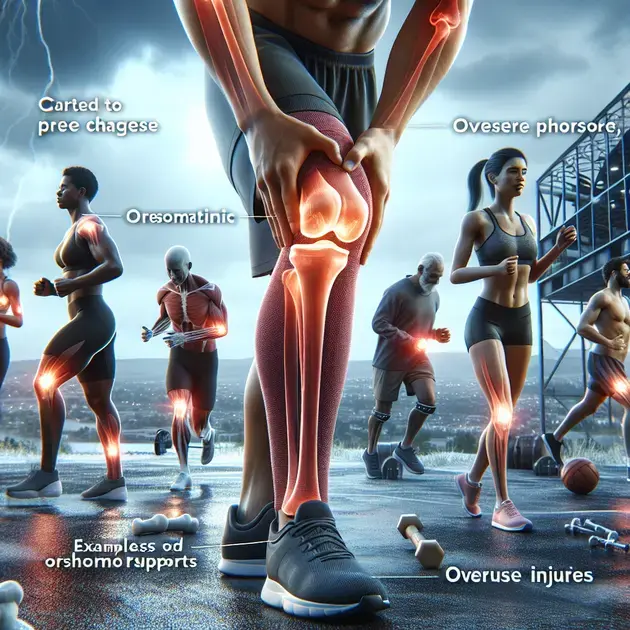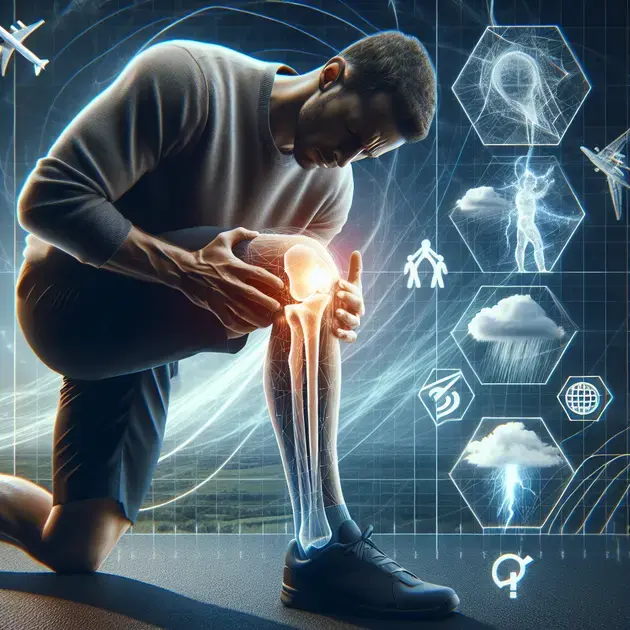If you find yourself wondering, “Why do my knees hurt?” you are not alone. Knee pain is a common complaint that can affect individuals of all ages, from athletes to the elderly.
There are numerous reasons why your knees may be hurting, ranging from overuse injuries to underlying medical conditions. In this blog post, we will explore some of the most common causes of knee pain and provide tips on how to alleviate discomfort.

Understanding the Impact of Overuse Injuries
Overuse injuries are common among individuals who participate in physical activities that involve repetitive movements of the knee joint, such as running, cycling, or jumping. These injuries occur when the tissues in and around the knee are subjected to excessive stress or strain over a period of time. Without proper rest and recovery, overuse injuries can lead to chronic knee pain and discomfort.
To understand the impact of overuse injuries on the knee, it is essential to recognize the signs and symptoms associated with such conditions. Swelling, tenderness, stiffness, and aching sensations are common indicators of an overuse injury. Additionally, limited range of motion and difficulty bearing weight on the affected knee may also be present.
Steps to Identify Overuse Injuries:
1. Consult with a healthcare professional such as an orthopedic specialist or physical therapist to assess your symptoms and receive a proper diagnosis.
2. Utilize online resources like WebMD or Healthline to learn more about the different types of overuse injuries that can affect the knee joint.
3. Keep a journal to track your symptoms and activities that may be contributing to the overuse injury. This information can help healthcare providers determine the best course of treatment.
4. Consider using mobile apps like MyFitnessPal or Strava to monitor your exercise routines and ensure that you are not overexerting yourself during physical activities.
5. Prioritize rest, proper nutrition, and cross-training activities to prevent overuse injuries and promote overall knee health.
Tips for Alleviating Knee Discomfort
Dealing with knee discomfort can significantly impact one’s daily routine and quality of life. Whether it is due to overuse injuries, arthritis, or other underlying conditions, there are various strategies that individuals can implement to alleviate knee pain and improve mobility.
When seeking relief from knee discomfort, it is important to explore both conservative and alternative treatment options. Physical therapy, over-the-counter pain medications, hot and cold therapy, and supportive knee braces are commonly recommended for managing knee pain.
Effective Ways to Alleviate Knee Discomfort:
1. Download the “Knee Pain Relief” app, which provides guided exercises and stretches specifically designed to strengthen the muscles around the knee and reduce pain.
2. Explore the benefits of acupuncture or acupressure for natural pain relief and improved blood circulation in the knee area. Websites like Healthline or AcuTake offer detailed information on these alternative therapies.
3. Invest in ergonomic furniture and accessories, such as a standing desk or ergonomic chair, to support proper posture and reduce pressure on the knees while sitting or standing for extended periods.
4. Incorporate anti-inflammatory foods, such as salmon, turmeric, and leafy greens, into your diet to help reduce joint inflammation and promote overall joint health.
5. Practice mindfulness and stress-reduction techniques, such as yoga or meditation, to manage pain perception and enhance relaxation, which can indirectly alleviate knee discomfort.

**Exploring the Connection Between Posture and Knee Health**
The Importance of Posture in Relation to Knee Health
Posture plays a crucial role in maintaining overall joint health, including the knees. Proper posture ensures that the body’s weight is evenly distributed, reducing unnecessary strain on the knees. When posture is poor, such as slouching or leaning forward, the knees can become misaligned, leading to increased pressure on certain areas of the knee joint. This additional stress can contribute to wear and tear, inflammation, and ultimately, knee pain.
How Posture Impacts Knee Alignment
Good posture aligns the body in a way that supports the natural curvature of the spine and distributes weight evenly across the joints. When the spine is properly aligned, the knees are also more likely to be aligned correctly, reducing the risk of discomfort or injury. On the other hand, poor posture can cause the pelvis to tilt forward or backward, throwing off the alignment of the entire lower body and putting undue stress on the knees.
Adjusting Posture for Better Knee Health
Improving posture can be a key factor in relieving and preventing knee pain. Simple adjustments, such as sitting up straight, engaging core muscles, and aligning the ears, shoulders, and hips, can make a significant difference in reducing strain on the knees. Additionally, incorporating exercises and stretches that focus on strengthening the core and back muscles can help support good posture and overall joint health.
Enhancing Posture Through Conscious Awareness
Developing mindfulness around posture can also be beneficial for knee health. Paying attention to body alignment throughout daily activities, such as standing, walking, and lifting, can help identify and correct poor posture habits that may be contributing to knee pain. By fostering an awareness of how posture affects knee health, individuals can proactively take steps to improve their overall musculoskeletal well-being.
The Relationship Between Posture and Long-Term Knee Health
Ultimately, maintaining good posture is essential for not only relieving existing knee pain but also preventing future issues. By prioritizing proper alignment and body mechanics, individuals can support the longevity and resilience of their knees, promoting overall joint health and reducing the risk of conditions like osteoarthritis. Investing in posture-improving habits and practices can lead to improved comfort, mobility, and quality of life.
**How Weather Changes Can Affect Knee Pain**
Understanding the Influence of Weather on Knee Pain
Weather changes have been reported to impact various health conditions, including knee pain. For some individuals, shifts in temperature, humidity, and barometric pressure can trigger or exacerbate knee discomfort, leading to increased stiffness, swelling, or sensitivity. Understanding how weather patterns can affect knee pain is essential for managing symptoms and implementing appropriate strategies for relief.
The Role of Atmospheric Pressure in Knee Pain
Changes in atmospheric pressure, often associated with incoming weather systems, can impact the fluid levels within the joints, including the knees. When atmospheric pressure drops, the tissues in the body may expand slightly, potentially causing increased pressure or irritation in the knee joint. This phenomenon can contribute to feelings of stiffness or achiness, particularly in individuals with existing knee issues.
Temperature and Its Effects on Joint Sensitivity
Temperature fluctuations have been linked to changes in joint sensitivity and pain perception. Cold weather, in particular, can cause muscles and soft tissues around the knee to contract and tighten, leading to decreased flexibility and potential discomfort. Additionally, extreme heat can also affect joint function, as excess warmth may increase inflammation in the knee joint, resulting in pain and reduced mobility.
Coping Strategies for Weather-Related Knee Pain
Managing knee pain triggered by weather changes may require a multifaceted approach. Strategies such as staying active to maintain joint flexibility, applying heat or cold therapy as needed for pain relief, and using supportive devices like knee braces can help alleviate discomfort during changing weather conditions. Additionally, staying well-hydrated, maintaining a healthy weight, and engaging in gentle exercises to strengthen the muscles around the knees can contribute to better overall joint health.
Tracking Symptoms and Weather Patterns
Keeping a journal or notes on how weather changes correspond to fluctuations in knee pain can provide valuable insights for managing symptoms. By tracking patterns and identifying triggers, individuals can proactively adjust their routines or treatment plans to better address weather-related knee discomfort. Consulting with healthcare professionals, such as orthopedic specialists or physical therapists, can also offer personalized guidance on coping strategies tailored to individual needs.
Adapting Lifestyle Choices to Support Knee Health in All Conditions
While weather changes may present challenges for knee pain management, making lifestyle choices that prioritize overall joint health can help mitigate the impact of environmental factors. Incorporating a balanced diet rich in anti-inflammatory foods, practicing regular low-impact exercise, and maintaining optimal posture and body mechanics are foundational steps in promoting resilient knees that can better withstand the effects of varying weather conditions.
**
Conclusion
**
Understanding the critical link between posture and knee health reveals that maintaining good posture is fundamental in supporting overall joint well-being, particularly concerning the knees. By ensuring proper alignment through conscious awareness and posture adjustments, individuals can alleviate strain on the knees, reducing the risk of discomfort and long-term issues like osteoarthritis.
Moreover, weather changes have been shown to impact knee pain, with shifts in temperature and atmospheric pressure potentially triggering or worsening knee discomfort. Developing coping strategies and tracking symptoms related to weather patterns can aid in managing knee pain effectively, alongside seeking professional guidance for personalized treatment plans.
Adapting lifestyle choices to prioritize joint health can further enhance resilience against environmental factors affecting knee pain. Incorporating a balanced diet, engaging in suitable exercises, and maintaining optimal posture are foundational steps in promoting strong and adaptable knees that can withstand varying weather conditions, ultimately enhancing quality of life and mobility.